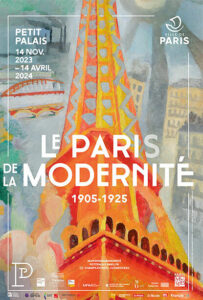
“Le Paris de la Modernité: 1905-1925” is an exhibition revisiting the Paris art scene from the end of the Belle Époque to the Roaring Twenties. It was a time when the city was exploding with a frenzy of creative energy attracting artists from all over the world. For Ernest Hemingway Paris in those years was a moveable feast (until April 14, 2024. Modernism sought a new alignment with modern times. The world was changing with new technologies rapidly affecting how people lived, traveled, worked… and made war. Artists felt they needed to change too. Many did while exploring new imagery, materials and techniques. “Le Paris de la Modernité” (at the Petit Palais) tells how the modern art story played out in Paris from 1905 to 1925.
The exhibition includes paintings from art movements which flowered in the first decades of the 20th century, such as Fauvism, Cubism, Expressionism, Futurism, Dada and Surrealism. The paintings are juxtaposed with timelines describing major events happening at the time. For example the Ballet Russes’ performance of “The Rite Of Spring” —with an avant-garde score by Stravinsky and choreography by Nijinsky— caused a riot at the Theatre du Champs-Elysees in 1913. And the ballet “Parade” —with a one-act scenario by Jean Cocteau, music by Erik Satie and costumes designed by Picasso (Theatre du Chatelet, 1917) —was greeted by both boos and cheers. Apollinaire, who wrote the program notes for “Parade,” described Picasso’s designs as “a kind of surrealism” three years before Surrealism developed as an art movement in Paris.
“Le Paris de la Modernité: 1905-1925” brings together almost four hundred works by Robert Delaunay, Sonia Delaunay, Marcel Duchamp, Marie Laurencin, Fernand Léger, Tamara de Lempicka, Amedeo Modigliani, Chana Orloff, Pablo Picasso, Marie Vassilieff and many others. It also features clothing designs by Paul Poiret and Jeanne Lanvin, jewellery by Cartier, a plane from Le Bourget Musée de l’Air et de l’Espace and even a car on loan from the Musée national de l’Automobile in Mulhouse. Through fashion, cinema, photography, painting, sculpture, and drawing, as well as dance, design, architecture, and industry, this exhibition revisits a time when Paris was unquestionably the No. 1 art capital of the world.
“Le Paris de la Modernité: 1905-1925,” Petit Palais, until April 14, 2024.

